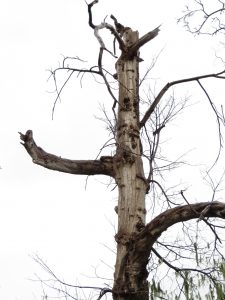
source for a variety of wildlife.
A wildlife tree is a dead or dying tree that is left to decompose and deteriorate naturally.
It is an important part of the forest’s ecosystem providing valuable habitat for the conservation and enhancement of wildlife.
A wildlife tree is a food source and habitat for mammals, birds, amphibians, insects, fungus and bacteria. In British Columbia more than 90 species of vertebrates and invertebrates depend to some extent on wildlife trees. Additionally, 18% of all bird species use the cavities of wildlife trees for breeding.
Trees have a lifespan just like all other living organisms, at some point they die. The causes can be many; drought, fungal, insect infestation or simply old age. A dead tree does not automatically need to removed; it can often be left to become a valuable wildlife tree.
A dead tree a often sound for several years before parts or the whole tree fails. The length of time that a dead tree can stand depends largely on the cause of its demise. If it is a natural cause, like drought, the tree will probably be structurally sound for some time. On the other hand, if the cause is root rot, failure could be imminent.
Dead and dying trees that do not endanger people and property can be left to decompose and deteriorate; they will eventually fall on the forest floor creating habitats there. Trees or parts of them that have the potential to fall on people and property will need an initial assessment by a qualified tree risk assessor to established if they are good wildlife tree candidates. Regular inspections and assessments on these trees are essential as it will decipher if they can be left, be modified, or need to be removed.
To conclude, a dead tree has many benefits to wildlife and the ecosystem. Often the tree can be left for several years before in needs to be removed. Modifications or removal may be needed if there are safety concerns for people and property. Initial and ongoing assessment of these trees are important as it will establish what actions are needed for making them valuable and safe wildlife trees.

